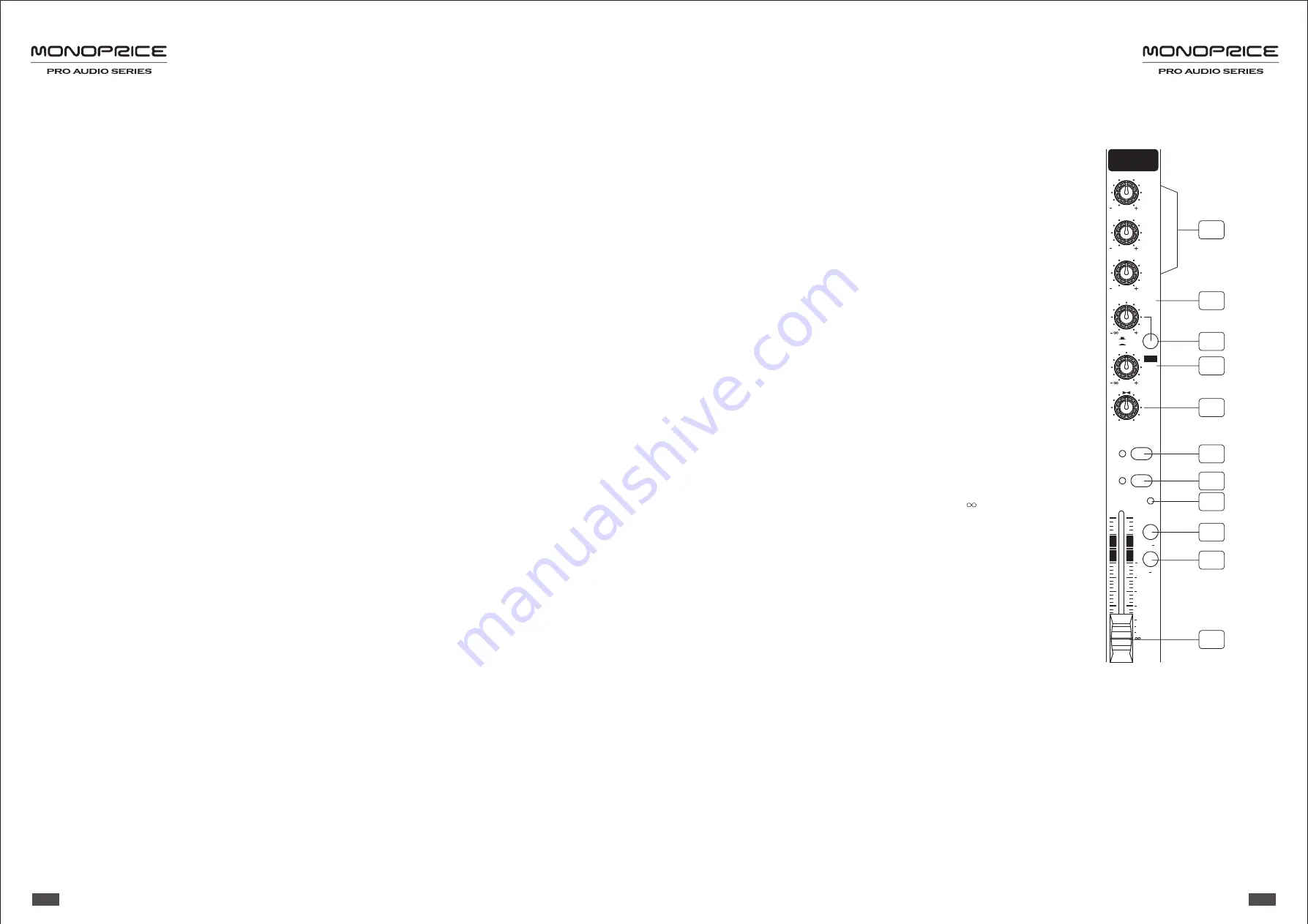
This is the treble control. You can use it to get rid of
high frequency noises or to boost the sound of cymbals or
the high harmonics of the human voice. The gain range
goes from -15dB
to +15dB, with a center
frequency of
12kHz.
This is the mid range control. It can affect most
fundamental frequencies of all musical instruments and
human voice. An attentive use of this control will give you
a very wide panorama of sound effects. The range goes from
-15dB
to +15 dB, with a center
frequency of 2.5kHz.
L
OW
This is the bass control. It can affect low frequency sounds,
such as male voice, kick drum, or bass guitar. The range
goes from -15dB to +15dB, with a center frequency of
80Hz.
9) PRE/POST
Each channel is equipped with a PRE/POST button. When in
the PRE position, the AUX signal is sent directly to the
output, bypassing the fader. When in the POST position, the
fader controls the AUX signal level.
11) PAN / BAL CONTROL
For mono inputs, the PAN control determines the position of the signal in the stereo soundstage.
For stereo inputs, it controls the balance between the left and right channel signals.
12) MUTE
Each channel is equipped with a MUTE button. Pressing this button is equivalent to turning the
fader all the way down, which mutes the corresponding channel output, except for the PRE AUX
sends, channel INSERT send, and SOLO (in PFL mode). When MUTE is activate, the MUTE LED will
illuminate.
7) EQUALIZER
H
I
MID
8) AUX
These controls are used to adjust the level of the signal
sent
to the AUX buses. Their adjustable
range is from - to
+15dB
.
10) DFX / POST
These controls are used to adjust the level of the POST FADER
signal sent to the DFX
(AUX) SENDS output, which can be
used for
monitor applications, as well as effects & sound
processor inputs.
PAN
MUTE
PFL
PEAK
1
DFX
POST
POST
PRE
AUX
EQ
HI
LOW
MID
1
GR1 2
L R
15
R/2
L/1
15
10
dB
5
0
5
10
20
30
40
60
15
15
0
15
15
0
15
15
0
15
12KHz
2.5KHz
80Hz
7)
8)
9)
10)
11)
12)
13)
15)
14)
16)
17)
This control is used to assign the signal from FX to the AUX SEND output.
31) PROGRAM
(PUSH)
Use this knob to select the desired effect for the mix. There are a total of 100
effects, with 10 variations for each of the 10 basic effects. Basic effects include
Echo, Echo+Verb, Tremolo, Plate, Chorus, Vocal, Rotary, Small Room, Verb,
and Large Hall. When you have selected the desired effect, push the knob to store
the selection.
32)
DIGITAL EFFECTS DISPLAY
Displays the number of the selected effect preset.
33) PHANTOM LED
This LED indicates
when phantom
power is switched on.
34 PWR LED
This LED indicates when the mixer is powered on.
35)
2TK IN / 2TK OUT
2TK IN
Use the 2TK IN input to connect a tape deck, CD player, or other similar audio source
device. This input can be assigned to either the Control Room output or the Main
Mix.
You can assign the signal coming from the Tape Recorder either to a pair of
studio monitor using the control room assignment on the front panel or you can
also send the signal directly to the Main Mix.
2TK OUT
The 2TK OUT output sends the Main Mix to an external device, such as a tape or
digital recorder.
36) MAIN MIX OUTPUT
This stereo output features balanced XLR and 1/4" TRS connectors. The Main Mix
output is typically routed to an amplifier.
37) ST RETURNS
These 1/4" TS jacks are typically used to return the stereo signal from an effects device back
into the Main Mix. They can also be used as additional auxiliary inputs.
38) CTRL-ROOM
These 1/4" TS jacks are used to send the signal out to studio monitor speakers or to a second
amplifier.
30) FX TO AUX
39) FOOT SWITCH
Use this 1/4" TS jack to connect an external foot pedal for an alternate method of
toggling DFX MUTE on/off.
10
7








